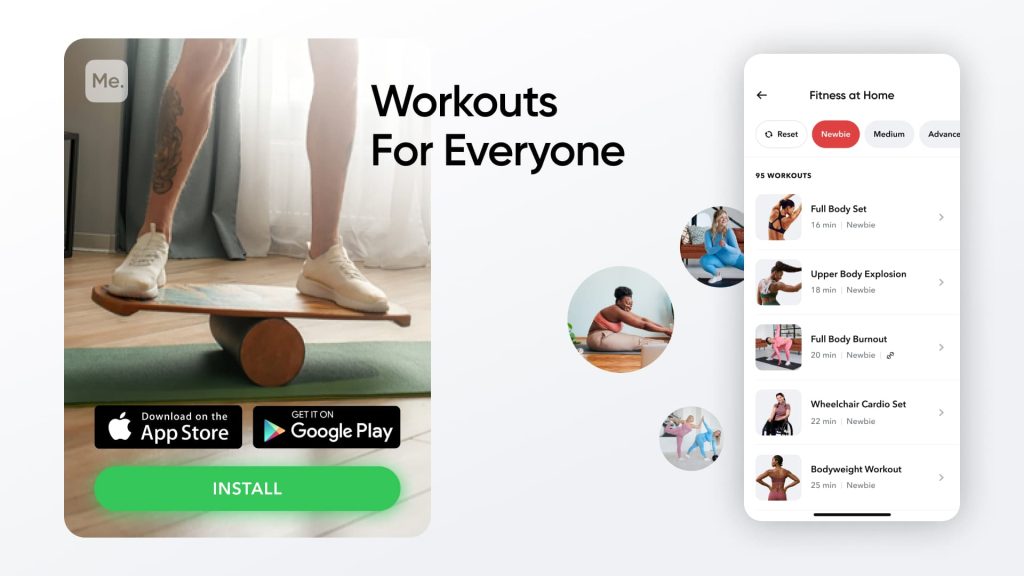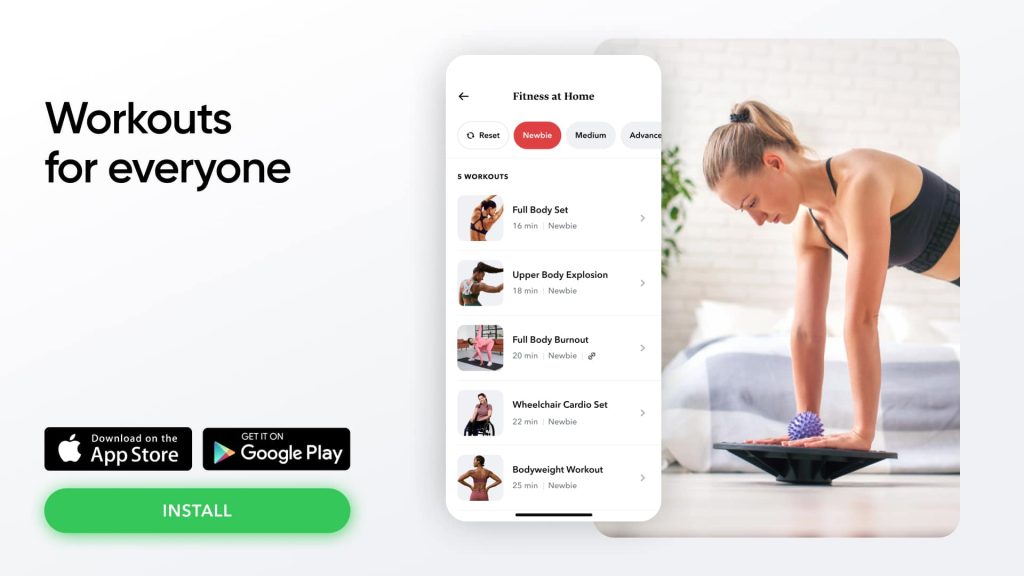From rudimentary tools used by ancient cultures to balance on, to the modern-day contraptions used in physiotherapy, balance boards have come a long way. While their primary function remains the same, the purposes for which they are used have expanded significantly. Primarily, balance boards are used to improve balance and proprioception. Proprioception is the ability to sense the position of your limbs and joints in space. It is an important aspect of movement and coordination. Poor proprioception can lead to clumsiness and a greater risk of injury (3). But that’s not all these seemingly simple boards can do. Read on to learn about the benefits, drawbacks, and exercises you can do with a balance board.
Get your personalized
meal plan!
Benefits Of Using A Balance Board
There are many benefits that come with using a balance board. These include:
Improved Balance
Your body’s ability to balance is brought about by several systems. Here is how it works (1):
- The eyes tell the brain where your body is in space.
- Proprioceptors, which are sensors located in your muscles and joints, provide information about your limbs’ position and movement.
- The vestibular system, located in the inner ear, helps the brain process information about movement and head position.
All of these systems work together to help you maintain your balance.
When one or more of these systems is not working properly, you may have trouble maintaining your balance. This can lead to falls and other accidents.
A balance board can help improve your balance by providing a challenge to these systems. By constantly adjusting to the board’s movements, you can train your body to better process information from all of its balance-related systems (1).
Improved Concentration And Coordination
Because using a balance board requires focus and coordination, it can help improve these skills (a). This is especially beneficial for children and older adults, who may have trouble with attention and coordination.
Read More: How To Lose 15 Pounds In A Month: Dietary Changes You Need To Get On Board With
Better Posture
Poor posture is a common problem these days. A lot of us spend our days hunched over computers or phones, which can lead to rounded shoulders and a hunched back.
This poor posture can lead to muscle imbalances and pain. It can also make it harder to balance, as your center of gravity is thrown off (2).
Standing on a balance board can help improve your posture by engaging muscles that are often neglected when you’re sitting or standing still. As you adjust your body to stay balanced on the board, you will naturally start to stand up straighter.
Stronger Joints
Joints are what connect our bones and allow us to move. They are held together by ligaments and muscles, which support and stabilize them.
When you don’t use your joints regularly, they can become weak and unstable. This can lead to joint pain and a greater risk of injury.
Standing on a balance board helps strengthen the muscles and ligaments that support your joints. This can help improve joint stability and reduce the risk of pain and injury (1).
Better Reaction Time
Your reaction time is the amount of time it takes for your body to respond to a stimulus. This is an important skill, as it can help you avoid accidents and injuries.
Using a balance board can help improve your reaction time by providing a constantly changing environment. As you learn to adjust your body to the board’s movements, you will also sharpen your reflexes.
If you’ve mustered up the courage to crush your weight loss goal, let Betterme take the sting out of this demanding process. Our app will help you restructure your habits, remold your life and crank up your fitness results!
Drawbacks Of Using A Balance Board
While balance boards offer many benefits, there are also some drawbacks to consider. These include:
Injury Risk
Because balance boards require you to constantly adjust your body to stay balanced, there is a risk of injury if you don’t use them correctly.
Make sure to warm up before using a balance board, and start with simple exercises. As you get more comfortable, you can move on to more challenging exercises.
It’s also important to listen to your body. If you feel pain, stop immediately and rest.
Limited Use
Balance boards can only be used for standing exercises. This means that if you’re looking for a full-body workout, you’ll need to use other equipment as well.
Types Of Balance Boards
There are two main types of balance boards: rocker boards and wobble boards.
Rocker Boards
Rocker boards have two curved surfaces that rock back and forth. They usually have a non-slip surface, making them ideal for beginners.
Wobble Boards
Wobble boards have a round platform that sits on top of a dome or cylinder. This allows the board to rotate in all directions.
Wobble boards are more challenging than rocker boards, so they’re best for people who have experience with balance training.
Read More: Twist Board Weight Loss: Working Your Muscles By Simply Wobbling About
Exercises To Do On A Balance Board
Here are some simple exercises you can do on a balance board to improve your balance, coordination, and strength:
Single-Leg Stand
- Stand on the board with one foot. Slowly lift your other leg off the ground and hold it in the air for 10 seconds.
- Lower your leg and repeat with the other leg.
Front To Back Rock
- Stand on the board with both feet.
- Slowly shift your weight forward, so that the front of the board starts to lift off the ground.
- Hold for 10 seconds, then slowly shift your weight back.
Side To Side Rock
- Stand on the board with both feet.
- Slowly shift your weight to one side, so that the board starts to tilt.
- Hold for 10 seconds, then slowly shift your weight to the other side.
Plank
- Get into a push-up position, with your hands on the board and your feet on the ground.
- Engage your core muscles
- Keep your body in a straight line and hold for 30 seconds.
- Avoid locking out your elbows, instead keep a slight bend in them.
Push-Ups
- Get into a push-up position, with your hands on the board and your feet on the ground.
- Bend your elbows and lower your body until your chest touches the board.
- Push back up to the starting position.
- Repeat for 10-12 reps.
Squats
- Stand on the board with your feet shoulder-width apart.
- Slowly lower your body into a squat position.
- Make sure your knees don’t go past your toes.
- Hold for 10 seconds, then slowly stand back up.
- Repeat for 10-12 reps.
Side Shuffle
- Stand on the board with both feet.
- Keeping your feet shoulder-width apart, shuffle to the right and then to the left.
Leg Swings
- Stand on the board with both feet.
- Swing one leg forward and backwards, then switch to the other leg.
- As you get more comfortable, you can try swinging your legs side to side instead of forward and backwards.
Reasons why BetterMe is a safe bet: a wide range of calorie-blasting workouts, finger-licking recipes, 24/7 support, challenges that’ll keep you on your best game, and that just scratches the surface! Start using our app and watch the magic happen.
Can A Balance Board Help You Lose Weight?
Yes, balance boards can help you lose weight. They provide a full-body workout and can help to increase your heart rate and burn calories. As with any exercise, the more challenging the exercise, the more calories you’ll burn.
To maximize weight loss, pair balance board exercises with a healthy diet. Eating nutritious foods will help to fuel your workouts and help your body to recover after exercise.
Do Balance Boards Build Muscle?
Muscle building comes down to two things: resistance and repetitions. When you exercise on a balance board, you’re using your own body weight as resistance. This can help to build muscle, especially in the legs, glutes, and core.
Repetitions are also important for muscle building. To see results, aim for 3-5 sets of 8-12 repetitions for each exercise.
Note that using a balance board only may not be enough to build muscle. You may need to add other types of resistance, such as dumbbells or resistance bands, to see results.
How Long Should You Stand On A Balance Board?
It’s best to start with shorter sessions and gradually increase the amount of time you spend on the balance board. Beginners should aim for 1-2 minutes per session, 3-4 times per week. As you get stronger and more comfortable, you can increase the duration of your sessions.
If you’re using a balance board for physical therapy or rehabilitation, your therapist will likely give you specific guidelines on how long to stand on the board.
Are Balance Board Standing Desk Benefits Worth It?
One increasingly popular use of balance boards is as a standing desk. Standing desks have been shown to have a number of health benefits, including improved posture, increased calorie burn, and reduced risk of obesity and heart disease.
Rather than sitting for long periods of time, standing desks allow you to move and shift your weight, which can help to reduce fatigue and improve focus.
Using it in conjunction with a balance board further amplifies the benefits, allowing you to get a workout while you work.
If you’re considering using a balance board at your standing desk, ensure that the board is stable and won’t slide out from under you. You may also want to consider using a mat to protect your floors.
The Bottom Line
When used regularly, balance boards can help to improve your balance, coordination, and strength. They can also help you lose weight and build muscle. If you’re new to balance training, start with simple exercises and gradually increase the difficulty as you get more comfortable.
DISCLAIMER:
This article is intended for general informational purposes only and does not serve to address individual circumstances. It is not a substitute for professional advice or help and should not be relied on for making any kind of decision-making. Any action taken as a direct or indirect result of the information in this article is entirely at your own risk and is your sole responsibility.
BetterMe, its content staff, and its medical advisors accept no responsibility for inaccuracies, errors, misstatements, inconsistencies, or omissions and specifically disclaim any liability, loss or risk, personal, professional or otherwise, which may be incurred as a consequence, directly or indirectly, of the use and/or application of any content.
You should always seek the advice of your physician or other qualified health provider with any questions you may have regarding a medical condition or your specific situation. Never disregard professional medical advice or delay seeking it because of BetterMe content. If you suspect or think you may have a medical emergency, call your doctor.
SOURCES:
- Balance Training Programs in Athletes – A Systematic Review (2017, sciendo.com)
- HARMFUL CONSEQUENCES OF A BAD POSTURE (n.d., neurosurg.org)
- The effectiveness of proprioceptive training for improving motor function: a systematic review (2015, nih.gov)













